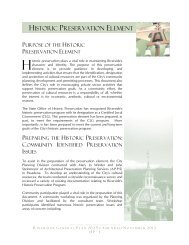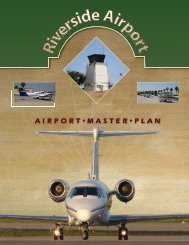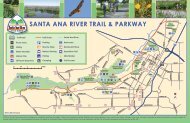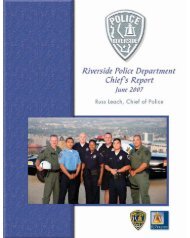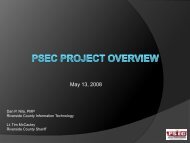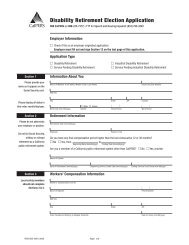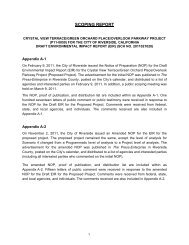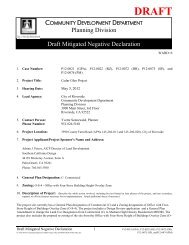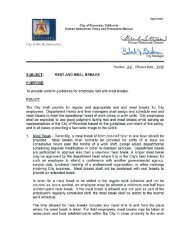Northside - City of Riverside
Northside - City of Riverside
Northside - City of Riverside
Create successful ePaper yourself
Turn your PDF publications into a flip-book with our unique Google optimized e-Paper software.
developed for the city <strong>of</strong> <strong>Riverside</strong> and figure prominently in the development <strong>of</strong><br />
many areas not explored in depth here, as they do not relate to the history <strong>of</strong><br />
development, the nature <strong>of</strong> the extant historic resources, or the historic inhabitants<br />
<strong>of</strong> the survey area. The theme <strong>of</strong> Immigration and Ethnic Diversity has been<br />
recommended for further study as association with ethnic groups, particularly<br />
<strong>Northside</strong>rs <strong>of</strong> Hispanic descent, could not be fully developed.<br />
Themes that have been developed in this historic context are organized according to<br />
major periods <strong>of</strong> settlement and growth and include Early Settlement on the<br />
<strong>Northside</strong> 1870-1900, Early Development 1901-1918, Suburban Development 1919-<br />
1941, and Post-WWII Development 1946-1959. History and development, which<br />
includes a discussion <strong>of</strong> related property types and architectural styles, are explored<br />
within each period and presented chronologically. The <strong>Northside</strong> is a very large<br />
area, encompassing roughly 2 square miles that was developed over a period <strong>of</strong><br />
decades. Over time, areas distinguished by associated property type and use<br />
emerged within the reduced survey area <strong>of</strong> less than 1 square mile, providing a<br />
logical pattern for organization for the context statement. Thus, each main area <strong>of</strong><br />
development – Fairmount Heights, File’s Island, Southeast Quadrant, Main Street<br />
Industrial Corridor, Freeway Industrial Interchange, and North <strong>of</strong> State Route 60<br />
(SR-60) – are summarized, after a brief historical overview, and are explored within<br />
the applicable themes introduced above (Figure 2).<br />
HISTORICAL OVERVIEW<br />
Approximately 50 miles east, southeast <strong>of</strong> Los Angeles, the city <strong>of</strong> <strong>Riverside</strong> lies on a<br />
plain that is interrupted by the Santa Ana River to the west and a series <strong>of</strong> foothills<br />
that are known as Rubidoux Mountain, Box Springs Mountain, Jurupa Mountains,<br />
Pedley Hills, Pachappa Hill, and Victoria Hill, all <strong>of</strong> which partially define the <strong>City</strong>’s<br />
boundaries. A series <strong>of</strong> arroyos from the eastern hills to the Santa Ana River crosses<br />
the <strong>Riverside</strong> plain. The Tequesquite Arroyo, the largest <strong>of</strong> the arroyo system,<br />
largely confined development to the original townsite, now <strong>Riverside</strong>’s downtown<br />
core, for over four decades.<br />
The greater <strong>Riverside</strong> area was originally inhabited by several Native American<br />
groups, including the Cahuilla, Serrano, Luiseno, and Gabrieliño Indians, with the<br />
<strong>Northside</strong> area <strong>of</strong> <strong>Riverside</strong> specifically within the traditional cultural territory <strong>of</strong><br />
the Cahuillas and Gabrieliños (LSA 2005:5). The present-day <strong>Riverside</strong> area received<br />
its first European visitors in 1774-1776, shortly after the beginning <strong>of</strong> Spanish<br />
colonization <strong>of</strong> Alta California in 1769. At that time, Juan Bautista de Anza, the<br />
famed Spanish explorer, reported that several Gabrieliño villages were found near<br />
the Anza Narrows on the Santa Ana River, approximately three miles southwest <strong>of</strong><br />
the survey area (Patterson 1996:120; Gunther 1984:25-26). After the establishment <strong>of</strong><br />
Mission San Gabriel in 1771, the <strong>Riverside</strong> area became one <strong>of</strong> the mission's principal<br />
20



